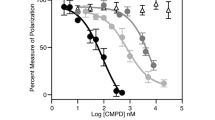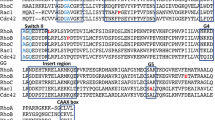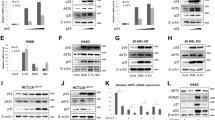Abstract
Small GTPases of the Rho family play a central role in cellular processes that involve the reorganization of the actin-based cytoskeleton. Rho-related GTPases, which include Rac and Cdc42, can also regulate gene expression often through the activation of kinase cascades leading to enhanced activity of stress activated protein kinases (SAPKs), including JNK and p38 MAP kinases. As SAPKs are implicated in programmed cell death, these observations suggest that Rho GTPases may promote the initiation of the apoptotic process. However, recent reports suggest that Rho GTPases can have either a protective or a pro-apoptotic role, depending on the particular cellular context. In an effort to explore the molecular mechanisms underlying these divergent biological activities, we asked whether there was indeed a correlation between the ability to induce SAPKs and apoptosis by Rho family members. We found that although constitutively activated (Q61L) mutants of Rac1, Cdc42, and RhoG, a Rac1 related GTPase of unknown function, potently induce JNK in COS 7 cells, none of these GTPases could induce apoptosis, nor enhance uv-induced cell death. In contrast, Rac1 and RhoG efficiently protected cells from uv-induced apoptosis. Furthermore, we provide evidence that Rac1 and RhoG can activate both apoptotic and anti-apoptotic pathways. Whereas the former is mediated through JNK, the latter is independent on the transcriptional activation of NF-κB, a pro-survival pathway, but results from the direct interaction of these GTPases with phosphatidylinositol 3-kinase (PI3K) and the stimulation of Akt. Together, these findings indicate that members of the Rho family of small GTP-binding proteins can provoke the concomitant stimulation of two counteracting signaling pathways, and that their balance ultimately determines the ability of these GTPases to promote cell survival or death.
This is a preview of subscription content, access via your institution
Access options
Subscribe to this journal
Receive 50 print issues and online access
$259.00 per year
only $5.18 per issue
Buy this article
- Purchase on Springer Link
- Instant access to full article PDF
Prices may be subject to local taxes which are calculated during checkout







Similar content being viewed by others
Abbreviations
- DMSO:
-
dimethyl sulfoxide
- FITC:
-
fluorescein isotiocyanate
- GFP:
-
green fluorescent protein
- HA:
-
hemagglutinin epitope tag
- HRP:
-
horseradish peroxidase
- H2B:
-
histone 2B
- JNK:
-
c-jun N-terminal kinase
- MAP kinase:
-
mitogen activated protein kinase
- MBP:
-
myelin basic protein
- ONPG:
-
o-nitrophenyl β-D-galactopyranoside; PBS-phosphate buffered saline
- PI3K:
-
phosphatidylinositol-3-OH kinase
- PVDF:
-
polyvinylidene fluoride
- s.e.m.:
-
standard error of the mean
References
Bazenet CE, Mota MA, Rubin LL . 1998 Proc. Natl. Acad. Sci. USA 95: 3984–3989
Blangy AE, Vignal E, Schmidt S, Debant A, Gauthier-Rouviere C, Fort P . 2000 J. Cell Sci. 113: 729–739
Bobak D, Moorman J, Guanzon A, Gilmer L, Hahn C . 1997 Oncogene 15: 2179–2189
Boehm JE, Chaika OV, Lewis RE . 1999 J. Biol. Chem. 274: 28632–28636
Bokoch GM, Vlahos CJ, Wang Y, Knaus UG, Traynor-Kaplan AE . 1996 Biochem. J. 315: 775–779
Bonni A, Brunet A, West AE, Datta SR, Takasu MA, Greenberg ME . 1999 Science 286: 1358–1362
Brown K, Franzoso G, Baldi L, Carlson L, Mills L, Lin YC, Gerstberger S, Siebenlist U . 1997 Mol. Cell. Biol. 17: 3021–3027
Chan TO, Rittenhouse SE, Tsichlis PN . 1999 Annu. Rev. Biochem. 68: 965–1014
Chen YR, Tan TH . 2000 Int. J. Oncol. 16: 651–662
Chiariello M, Marinissen MJ, Gutkind JS . 2000 Mol. Cell. Biol. 20: 1747–1758
Coso OA, Chiariello M, Yu JC, Teramoto H, Crespo P, Xu N, Miki T, Gutkind JS . 1995 Cell 81: 1137–1146
Davis RJ . 2000 Cell 103: 239–252
Dickens M, Rogers JS, Cavanagh J, Raitano A, Xia Z, Halpern JR, Greenberg ME, Sawyers CL, Davis RJ . 1997 Science 277: 693–696
Franke TF, Yang SI, Chan TO, Datta K, Kazlauskas A, Morrison D, Kaplan DR, Tsichlis PN . 1995 Cell 81: 727–736
Gauthier-Rouviere C, Vignal E, Meriane M, Roux P, Montcourier P . 1998 Mol. Cell. Biol. 9: 1379–1394
Genot EM, Arrieumerlou C, Ku G, Burgering BM, Weiss A, Kramer IM . 2000 Mol. Cell. Biol. 20: 5469–5478
Gomez J, Martinez AC, Gonzalez A, Rebollo A . 1998 Immunol. Cell Biol. 76: 125–134
Gutkind JS, Lacal PM, Robbins KC . 1990 Mol. Cell. Biol. 10: 3806–3809
Hall A . 1998 Science 279: 509–514
Han J, Luby-Phelps K, Das B, Shu X, Xia Y, Mosteller RD, Krishna UM, Falck JR, White MA, Broek D . 1998 Science 279: 558–560
Hengartner MO . 2000 Nature 407: 770–776
Horii Y, Beeler JF, Sakaguchi K, Tachibana M, Miki T . 1994 EMBO J. 13: 4776–4786
Ise K, Nakamura K, Nakao K, Shimizu S, Harada H, Ichise T, Miyoshi J, Gondo Y, Ishikawa T, Aiba A, Katsuki M . 2000 Oncogene 19: 2951–2956
Katoh H, Yasu H, Yamaguchi Y, Aoki J, Fujita H, Mori K, Negishi M . 2000 Mol. Cell. Biol. 20: 7378–7387
Kimmelman AC, Osada M, Chan AM . 2000 Oncogene 19: 2014–2022
Klippel A, Reinhard C, Kavanaugh WM, Apell G, Escobedo MA, Williams LT . 1996 Mol. Cell. Biol. 16: 4117–4127
Konishi H, Matsuzaki H, Tanaka M, Takemura Y, Kuroda S, Ono Y, Kikkawa U . 1997 FEBS Lett. 410: 493–498
Kuan CY, Yang DD, Samanta Roy DR, Davis RJ, Rakic P, Flavell RA . 1999 Neuron 22: 667–676
Levresse V, Butterfield L, Zentrich E, Heasley LE . 2000 J. Neurosci. Res. 62: 799–808
Lores P, Morin L, Luna R, Gacon G . 1997 Oncogene 15: 601–605
Madge LA, Pober JS . 2000 J. Biol. Chem. 275: 15458–15465
Minamoto T, Mai M, Ronai Z . 2000 Cancer Detect. Prev. 24: 1–12
Murga C, Fukuhara S, Gutkind JS . 2000 J. Biol. Chem. 275: 12069–12073
Murga C, Laguinge L, Wetzker R, Cuadrado A, Gutkind JS . 1998 J. Biol. Chem. 273: 19080–19085
Nishida K, Kaziro Y, Satoh T . 1999 Oncogene 18: 407–415
Pahl HL . 1999 Oncogene 18: 6853–6866
Perona R, Montaner S, Saniger L, Sanchez-Perez I, Bravo R, Lacal JC . 1997 Genes Dev. 11: 463–475
Reif K, Nobes CD, Thomas G, Hall A, Cantrell DA . 1996 Curr. Biol. 6: 1445–1455
Rodriguez-Viciana P, Warne PH, Dhand R, Vanhaesebroeck B, Gout I, Fry MJ . 1994 Nature 370: 527–532
Rubio I, Rodriguez-Viciana P, Downward J, Wetzker R . 1997 Biochem. J. 326: 891–895
Sabapathy K, Jochum W, Hochedlinger K, Chang L, Karin M, Wagner EF . 1999 Mech. Dev. 89: 115–124
Sable CL, Filippa N, Hemmings B, Van OE . 1997 FEBS Lett. 409: 253–257
Shimoke K, Yamagishi S, Yamada M, Ikeuchi T, Hatanaka H . 1999 Brain Res. Dev. Brain Res. 112: 245–253
Subauste MC, Von Herrath M, Benard V, Chamberlain CE, Chuang TH, Chu K, Bokoch GM, Hahn KM . 2000 J. Biol. Chem. 275: 9725–9733
Tolias KF, Cantley LC, Carpenter CL . 1995 J. Biol. Chem. 270: 17656–17659
Tournier C, Hess P, Yang DD, Xu J, Turner TK, Nimnual A, Bar-Sagi D, Jones SN, Flavell RA, Davis RJ . 2000 Science 288: 870–874
Whitmarsh AJ, Cavanagh J, Tournier C, Yasuda J, Davis RJ . 1998 Science 281: 1671–1674
Wymann MP, Pirola L . 1998 Biochim. Biophys. Acta. 1436: 127–150
Yang FC, Kapur R, King AJ, Tao W, Kim C, Borneo J, Breese R, Marshall M, Dinauer MC, Williams DA . 2000 Immunity 12: 557–568
Zhang S, Han J, Sells MA, Chernoff J, Knaus UG, Ulevitch RJ, Bokoch GM . 1995 J. Biol. Chem. 270: 23934–23936
Acknowledgements
We are especially grateful to C DeGraff and E Powell for excellent secretarial assistance. We thank Dr Siebenlist for providing the construct for h-IκBα S32G S36A, Dr Lenardo for the vector containing FLICE and Dr Davis for the kind gift of JIP-1 expression plasmids. Thanks to Dr Montaner and Dr Servitja for their critical reading of the manuscript.
Author information
Authors and Affiliations
Rights and permissions
About this article
Cite this article
Murga, C., Zohar, M., Teramoto, H. et al. Rac1 and RhoG promote cell survival by the activation of PI3K and Akt, independently of their ability to stimulate JNK and NF-κB. Oncogene 21, 207–216 (2002). https://doi.org/10.1038/sj.onc.1205036
Received:
Revised:
Accepted:
Published:
Issue Date:
DOI: https://doi.org/10.1038/sj.onc.1205036
Keywords
This article is cited by
-
Role of RhoG as a regulator of cellular functions: integrating insights on immune cell activation, migration, and functions
Inflammation Research (2023)
-
Metabolic labeling with an alkyne probe reveals similarities and differences in the prenylomes of several brain-derived cell lines and primary cells
Scientific Reports (2021)
-
The ZNF750–RAC1 axis as potential prognostic factor for breast cancer
Cell Death Discovery (2020)
-
Vav2 catalysis-dependent pathways contribute to skeletal muscle growth and metabolic homeostasis
Nature Communications (2020)
-
Elmo1 function, linked to Rac1 activity, regulates peripheral neuronal numbers and myelination in zebrafish
Cellular and Molecular Life Sciences (2020)



